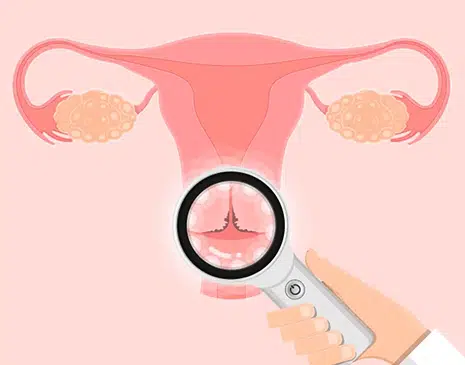Have you ever wondered what your own cervix looks like?
Whether you know your way around the female reproductive system or not, chances are you’ve heard about the female body part known as the cervix.
Despite many women not thinking about their cervix until they either book a pap smear or prepare for pregnancy, the cervix is responsible for some impressive functions within the female body. So, it’s clear that a woman’s cervix deserves to be celebrated, not shunned in stigma or shame.
For too long, the vulva, clitoris and vaginal canal have received all the attention. So, in tribute to women’s reproductive health, consider it time to learn everything there is to know about the cervix, including what a cervix looks like during different phases of a woman’s life (including the different menstrual cycles, pregnancy, and sex) and how you can find your cervix.
What are the functions of the cervix?
Consider the cervix to be the gatekeeper to the uterus. The bouncer to the internal lady parts, if you will. While there are many important things that can enter the cervix (tampons, sex toys, fingers, and penises are some of the things that keep the cervix busy), nothing should pass through to the uterus. So, the cervix has a 24/7 job of protecting the uterus and preventing unwanted germs from getting through.
There are also a few things that exit a woman’s body via the uterus, such as mucus, menstrual blood, and the occasional baby.
To sum it up, the cervix has three important functions, including:
- Producing cervical mucus during the fertile phase of the menstrual cycle, helping sperm travel from the vagina into the uterus
- Providing an opening during labour to allow the baby to pass through the birth canal
- Protecting the uterus from unwanted bacteria and foreign objects
What does a woman’s cervix look like?
The cervix is a cylinder shaped neck located at the top of the vaginal canal. When the cervix is closed, it looks like a dimple. When the cervix is open (e.g. during ovulation), it looks more like a smooth, pink doughnut.
Because the cervix is one of the internal parts of the female reproductive system, located in the lowermost part of the uterus, it can be difficult to view from the outside-in.
How can I see my own cervix?
If you were imagining your boyfriend, girlfriend, wife, or husband taking snaps for the cause of you seeing your own cervix, we have good news. You can view your unique cervix on your own, unassisted, in the comfort of your home.
Prior warning: it’s not as simple as squatting over a mirror, however you will still need a mirror. You’ll also need some lube, a small flashlight, and a speculum.
Don’t have a speculum stashed in the back of your bathroom cupboard?
The Beautiful Cervix Project is empowering people to check out their own cervices with handy cervical self-exam kits containing a hand mirror, miniature flashlight, organic lubricant, and the pièce de résistance; a reusable, plastic vaginal speculum (that’s way less daunting than the one handled by your doctor during a pap smear).
Once you’re armed with the right tools, find a safe, private location (like your bedroom or bathroom), and follow these steps to see your cervix:
- Assume the position
Assume a sturdy semi-reclined position with your lower back on a flat surface, your knees open, and heels together. - Find the location
Before getting eyeballs-deep with your own cervix, you’ll need to know where to find it. You can find your cervix by inserting one of your fingers into your vagina and gently feeling around. You’ll know you’ve found it when you can feel a little curved knob protruding into your vagina. Feel free to use lube if it’s more comfortable for you. - Lube up and insert
Here’s the part where your trusty tube of lube becomes your new best pal. Apply your lube onto the speculum, then insert the speculum (handles up) into the vagina towards the location you just discovered with your finger. - Press the speculum
Gently press the handles of the speculum to open them until you hear a ‘click’ sound that indicates the speculum is locked in place and will remain open until you’ve finished exploring your land down under. - Adjust the mirror
Next, hold your hand mirror between your legs, adjusting the angle until you can see inside your vagina. - Flashlight, flashlight
Using your mini flashlight, shine the light to reflect off the mirror and into the vagina. Depending on your cervical position, your cervix should now be visible, or visible with minor adjustment of the speculum and/or mirror.
Hint: it’s the tiny, pink doughnut-looking body part. - Admire and observe
Now that you’ve located your cervix, your vision and fingers are free to roam and identify any abnormalities that may exist within your nether region.
Alternatively, you can ask your gynaecologist, or doctor to help you view your own nethers during your next medical consultation.
Why is it important to perform regular cervical checks?
Not only do regular cervical checks help to keep the uterus happy by keeping out bacteria and other germ carrying items, they’re one of best tools in the women’s health arsenal to protect from cervical cancer, other diseases, and infections like human papillomavirus (HPV).
Everyone from newly menstruating teens through to pregnant people and women with abnormal paps results can benefit from regular cervical self-checks to identify any abnormalities in skin texture (including lumps and bumps), skin colour, and cervical mucus.
If you notice anything abnormal in relation to your cervix, consult with your doctor for a full assessment.
6 Photos Of The Cervix You Need To See
To get to know your cervix, it’s handy to have some cervix pictures on standby for comparison purposes. However, remember that every person’s cervix is unique to them and may not look exactly like these cervix pictures.
During the follicular phase
During the follicular phase of your menstrual cycles, the visible part of the cervix protrudes into the vaginal canal and is covered by smooth, pink, squamous epithelium (a type of flat cell found throughout the body).

During the menstrual phase
During your monthly cycle, the cervix will release menstrual fluids and appear to be covered in blood. The centre will be open, resembling a dimple rather than a doughnut shape.

During the luteal phase
During the luteal phase, the cervix prepares for either pregnancy or menstruation (aka shark week) to occur. The average size of a cervix during the luteal phase is between 3 to 5 centimetres in length, and 2 to 3 centimetres in diameter.

During the ovulatory phase
During ovulation, the cervix looks like a doughnut as it opens to allow sperm to enter.

During sex
During sex, the cervix may be covered in bodily fluids, including semen if a man ejaculates with his penis still inside the vagina.
While some women find repeated thrusting into the cervix during sex to be enjoyable, other women find it incredibly painful and it can cause bruising or tearing of cervical tissue in some instances. Something to keep in mind if you spot bruising after a rough romp.

During pregnancy
During pregnancy, it’s common for a thick white vaginal discharge called leukorrhea to be present in the cervix.

Experiencing issues with your lady parts?
We’re here to help with hassle-free healthcare for women in Australia. Start a convo with a Youly doctor today!







